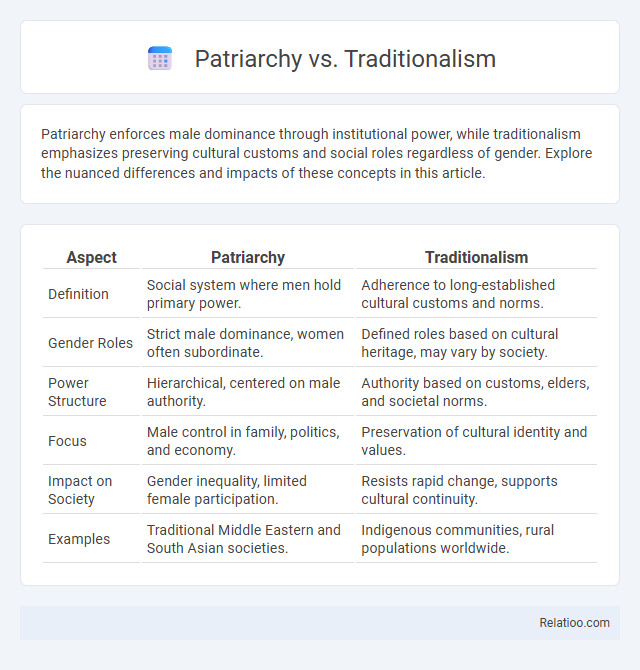Patriarchy enforces male dominance through institutional power, while traditionalism emphasizes preserving cultural customs and social roles regardless of gender. Explore the nuanced differences and impacts of these concepts in this article.
Table of Comparison
| Aspect | Patriarchy | Traditionalism |
|---|---|---|
| Definition | Social system where men hold primary power. | Adherence to long-established cultural customs and norms. |
| Gender Roles | Strict male dominance, women often subordinate. | Defined roles based on cultural heritage, may vary by society. |
| Power Structure | Hierarchical, centered on male authority. | Authority based on customs, elders, and societal norms. |
| Focus | Male control in family, politics, and economy. | Preservation of cultural identity and values. |
| Impact on Society | Gender inequality, limited female participation. | Resists rapid change, supports cultural continuity. |
| Examples | Traditional Middle Eastern and South Asian societies. | Indigenous communities, rural populations worldwide. |
Defining Patriarchy and Traditionalism
Patriarchy is a social system where men hold primary power and dominate roles in leadership, moral authority, and control over property. Traditionalism emphasizes preserving cultural or religious customs and values passed down through generations, often reinforcing established social roles, including gender-based expectations. Understanding these concepts helps you critically analyze how they shape societal structures and influence gender dynamics.
Historical Roots of Patriarchy
The historical roots of patriarchy trace back to ancient agrarian societies where male dominance was established through control of land and warfare, deeply influencing social structures and power dynamics. Traditionalism often reinforces these patriarchal norms by emphasizing the preservation of inherited cultural values and gender roles, which shaped many civilizations' governance and family systems. Understanding these origins helps you recognize how entrenched patriarchal values persist in modern societies, affecting gender equality and social organization.
Traditional Values Across Cultures
Traditional values across cultures emphasize family roles, social hierarchy, and cultural rituals that preserve heritage and community cohesion. Patriarchy, often intertwined with these values, prioritizes male authority and lineage, influencing laws and social norms. Your understanding of these frameworks helps navigate the complexities of cultural identity and social expectations.
How Patriarchy Shapes Gender Roles
Patriarchy shapes gender roles by establishing male dominance as a fundamental social order, defining men as primary authority figures and women as subordinate caretakers. Traditionalism often reinforces these roles by emphasizing cultural and historical norms, which can limit Your opportunities for gender equality and personal expression. Understanding these dynamics is essential for addressing gender disparities rooted in patriarchal systems.
Traditionalism and Social Order
Traditionalism emphasizes maintaining established social order and cultural norms, valuing continuity and stability within communities. It often supports hierarchical structures rooted in long-standing customs without necessarily enforcing gender dominance like patriarchy. Your understanding of social dynamics deepens by distinguishing between traditionalism's preservation of cultural practices and patriarchy's focus on male authority.
Overlapping Features of Patriarchy and Traditionalism
Patriarchy and Traditionalism both uphold hierarchical social structures that prioritize male authority and family-centric roles, reinforcing gender norms rooted in historical customs. These systems emphasize the preservation of established cultural values, where male dominance in decision-making and household leadership is normalized. Overlapping features include the promotion of patrilineal inheritance and gender-specific duties, which sustain societal stability through continuity of patriarchal traditions.
Key Differences Between Patriarchy and Traditionalism
Patriarchy is a social system where men hold primary power and dominate roles in leadership, moral authority, and control of property, while traditionalism emphasizes preserving cultural customs and practices regardless of gender roles. Your understanding of patriarchy highlights male dominance and systemic inequality, whereas traditionalism centers on valuing and maintaining established traditions and social order. The key difference lies in patriarchy's focus on gender-based power hierarchies versus traditionalism's broader commitment to historical continuity and cultural norms.
Modern Challenges to Patriarchy
Modern challenges to patriarchy arise from increased gender equality movements and evolving cultural norms that undermine traditional male dominance. Traditionalism often clashes with these changes by advocating for long-established gender roles and family structures rooted in historical patriarchy. Feminist ideologies and legislative reforms promote dismantling patriarchal systems, fostering diverse social and economic opportunities for women.
Traditionalism in Today’s Society
Traditionalism in today's society emphasizes the preservation of long-standing cultural, religious, and social norms that shape community values and family structures. Unlike patriarchy, which primarily centers on male dominance and power, traditionalism upholds broader societal customs that may include hierarchical roles but prioritize continuity and stability. Your understanding of these distinctions helps navigate how traditional values influence contemporary social dynamics without reducing them solely to gender-based power struggles.
The Future of Gender Dynamics
The future of gender dynamics will increasingly challenge patriarchy by promoting equality through progressive social reforms and shifting cultural norms. Traditionalism often resists these changes by emphasizing historical gender roles, but ongoing advocacy for women's rights, inclusive policies, and educational advancements drives transformation. Emerging trends indicate a gradual move toward more balanced power structures that dismantle patriarchal dominance while reevaluating traditional values in contemporary contexts.

Infographic: Patriarchy vs Traditionalism
 relatioo.com
relatioo.com